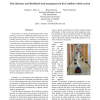3955 search results - page 85 / 791 » Comparing the Power of Robots |
TSMC
2002
14 years 9 months ago
2002
Imitation is a powerful mechanism whereby knowledge may be transferred between agents (both biological and artificial). Key problems on the topic of imitation have emerged in vario...
IROS
2008
IEEE
15 years 4 months ago
2008
IEEE
— Flying has an advantage when compared to ground based locomotion, as it simplifies the task of overcoming obstacles and allows for rapid coverage of an area while also providi...
122
click to vote
ATAL
2005
Springer
15 years 3 months ago
2005
Springer
We describe a very large scale distributed robotic system, involving a team of over 100 robots, that has been successfully deployed in large, unknown indoor environments, over ext...
DATE
2000
IEEE
15 years 2 months ago
2000
IEEE
Dynamic power management saves power by shutting down idle devices. Several management algorithms have been proposed and demonstrated effective in certain applications. We quantit...
103
click to vote
ICRA
2000
IEEE
15 years 1 months ago
2000
IEEE
This paper describes the progress of the BIP2000 project. This project, in which four laboratories are involved for 4 years, as uimed at the realization of the lower part of an an...

